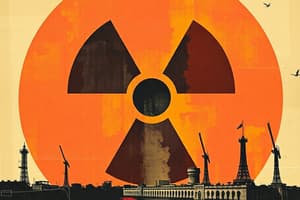Podcast
Questions and Answers
What process occurs when a photon collides with an atomic electron and only partially transfers its energy?
What process occurs when a photon collides with an atomic electron and only partially transfers its energy?
- Pair production
- Spontaneous fission
- Photoelectric effect
- Compton scattering (correct)
Which type of ionizing radiation can be significant, especially at high altitudes and latitudes?
Which type of ionizing radiation can be significant, especially at high altitudes and latitudes?
- Neutrons from (g,n) reactions
- Gamma rays from cosmic sources (correct)
- Neutrons from (a,n) reactions
- Protons from terrestrial sources
What is the unit used to measure ionizing radiation in air?
What is the unit used to measure ionizing radiation in air?
- Effective dose
- Equivalent dose
- Exposure (correct)
- Absorbed dose
What is the total ionizing dose to a population, weighted by the radiation type and the tissue or organ at risk?
What is the total ionizing dose to a population, weighted by the radiation type and the tissue or organ at risk?
Who reported the discovery of X-rays in 1895?
Who reported the discovery of X-rays in 1895?
In which year was the radioactivity of uranium discovered?
In which year was the radioactivity of uranium discovered?
What is the name of the centre established under the PM Dept in 1972?
What is the name of the centre established under the PM Dept in 1972?
What are the two types of radiation mentioned in the text?
What are the two types of radiation mentioned in the text?
Which type of radiation contributes the most to the average yearly global radiation dose?
Which type of radiation contributes the most to the average yearly global radiation dose?
What is the main source of ionising radiation in consumer products like smoke detectors and luminous watches?
What is the main source of ionising radiation in consumer products like smoke detectors and luminous watches?
What is the unit used to measure absorbed dose of ionising radiation?
What is the unit used to measure absorbed dose of ionising radiation?
What does A(t) = A0/2n represent in the context of radioactivity?
What does A(t) = A0/2n represent in the context of radioactivity?
Which type of radiation is characterized by high mass and charge, short range, and is considered an important internal hazard?
Which type of radiation is characterized by high mass and charge, short range, and is considered an important internal hazard?
What is the unit of measurement for disintegration rate, with 1 Bq equal to 1 disintegration per second (dps)?
What is the unit of measurement for disintegration rate, with 1 Bq equal to 1 disintegration per second (dps)?
Which radionuclide has the longest half-life among the following options?
Which radionuclide has the longest half-life among the following options?
What type of radiation is electromagnetic and characterized by long range, making it an external hazard?
What type of radiation is electromagnetic and characterized by long range, making it an external hazard?
What determines the identity and atomic mass of an element?
What determines the identity and atomic mass of an element?
What are atoms of the same element with different numbers of neutrons called?
What are atoms of the same element with different numbers of neutrons called?
What is the term for the spontaneous emission of ionizing radiation from unstable nuclides as they rearrange themselves into more stable configurations?
What is the term for the spontaneous emission of ionizing radiation from unstable nuclides as they rearrange themselves into more stable configurations?
What are particles in the nucleus of an atom that have no electrical charge called?
What are particles in the nucleus of an atom that have no electrical charge called?
Flashcards are hidden until you start studying
Study Notes
- Atoms are the smallest particles of matter that cannot be separated into simpler substances by ordinary chemical means.
- Elements are substances made up of atoms that have the same properties and cannot be separated into simpler substances. There are 118 known elements, and they can be represented on the periodic table.
- An atom is made up of a nucleus and orbiting electrons.
- The nucleus of an atom is made up of protons and neutrons, both of which determine the identity and atomic mass of the element. Protons are positively charged and electrons are negatively charged particles.
- The number of protons in an atom determines the element and the number of electrons equals the number of protons for an uncharged atom.
- Neutrons are particles in the nucleus of an atom that have no electrical charge. The number of neutrons in an atom can vary, leading to different isotopes of the same element. Race Element: Protons and Neutrons
- Isotopes are atoms of the same element with different numbers of neutrons. They are represented with the element symbol, mass number (protons + neutrons), and atomic number (protons).
- Stable nuclides have a correct balance of neutrons and protons, leading to nuclear stability. Unstable nuclides have an incorrect balance, leading to radioactivity and the emission of radiation.
- Radioactivity is the spontaneous emission of ionizing radiation from unstable nuclides as they rearrange themselves into more stable configurations. The rate of radioactive decay is measured in becquerels (Bq), which represents one nuclear transformation per second.
Studying That Suits You
Use AI to generate personalized quizzes and flashcards to suit your learning preferences.




